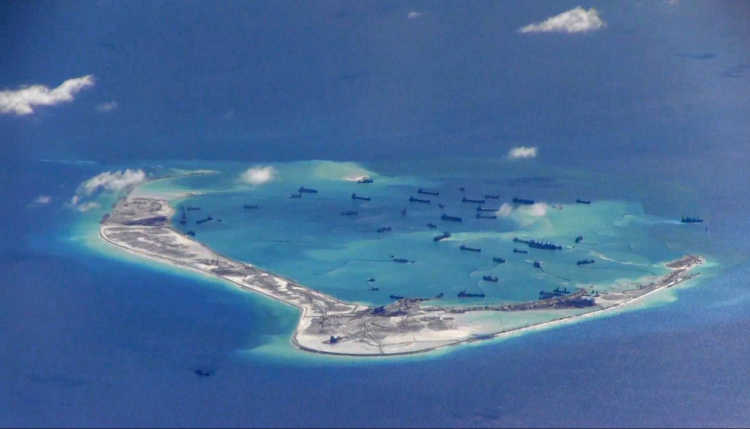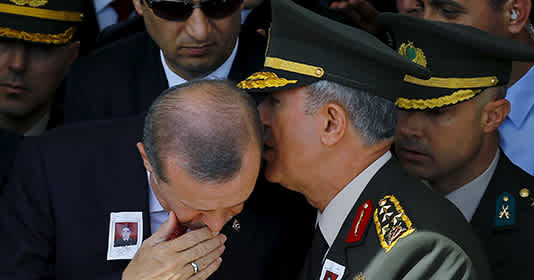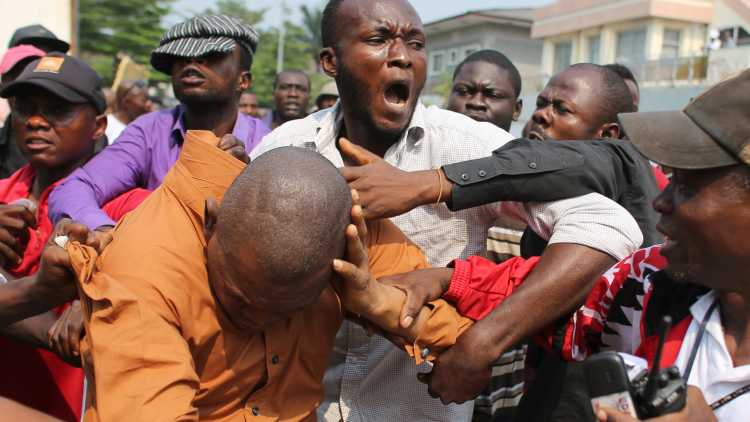- Home
- Publications
- GIGA Focus
- Material and Discursive Militarisation in Democracies
GIGA Focus Global
Material and Discursive Militarisation in Democracies
Number 6 | 2020 | ISSN: 1862-3581

Recent years have seen the expansion of the military’s visibility and social role in many democracies. Even before the Covid-19 pandemic, democracies across the world had been deploying their militaries in an expanding range of operations. This has raised concerns about a return of the military as a political actor and the militarisation of democratic politics.
Worries about the military becoming the “gravedigger of democracy” have resurfaced once again in recent years. Military coups in Africa, the expansion of military roles in law enforcement in Latin America, and an intensification of geostrategic conflicts in Asia have raised concerns about the militarisation of politics and its dangers for democratic processes, political rights, and civil liberties.
However, across the world’s democracies, there are few signs of a coherent trend towards the “material” militarisation of politics. Military coups and other forms of undue military influence on government formation are the exception in democratic countries, and the relative resource endowment of the military has actually declined over the last three decades.
Nonetheless, there has been a worrying trend of democracies deploying their militaries for an increasing range of non-traditional missions in response to external or domestic security threats, including anti-terrorism activities, crime fighting, and the maintenance of law and order.
To legitimate these non-traditional missions, democratic governments have engaged in a militarisation of the security discourse which portrays the use of military force as justified and “normal.” Over the medium to long term, these militarised discourses may lead to material militarisation and the erosion of civilian control and democratic quality.
Policy Implications
Democracies deploy their militaries in a range of operations, which are often accompanied by a militarised security discourse to legitimise the use of military force as a socially acceptable or “normal” tool of civilian politics. Over time, these militarised discourses may lead to material militarisation and the erosion of civilian control and democratic quality. External actors should, therefore, focus not only on reining in military coups and other forms of undue military influence on democratic politics, but also support the demilitarisation of security discourses in recipient countries.
As a reaction to the Covid-19 pandemic many countries in the world have deployed military forces to support ailing civilian administrative agencies and enforce curfews. This has not been confined to autocratic regimes in poor countries of the Global South with a long history of military involvement in politics, but has also taken place in many rich democracies of “the West” with uncontested civilian control over the armed forces. Nonetheless, in combination with a resurgence of military coups in Africa, an expansion of military roles in law enforcement in Latin America, and an intensification of geostrategic conflicts in Asia, there is concern about the military becoming a “gravedigger of democracy” that threatens democratic processes, curtails political rights, and undermines civil liberties (Kuehn 2019). This echoes a broader debate, expertly reviewed in a series of recent GIGA Focus publications, about whether we are witnessing a return of the military to the political scene after three decades of political dormancy.
In this GIGA Focus Global, we consider the evidence for a global trend toward the (re-)militarisation of politics in democracies. We argue that militarisation has two dimensions, one material and the other discursive. Material militarisation refers to the increase in power resources under the military’s control; discursive militarisation refers to the legitimation of the use of the military force as a socially acceptable or “normal” tool of civilian politics. While we do not find evidence of an overall material militarisation, we do see a trend towards the militarisation of political discourses in some of the world’s democracies. These militarised discourses may lead to material militarisation and the erosion of civilian control and democratic quality. Therefore, it is essential for democracies to be wary of militarising security discourses.
Global Patterns of Material Militarisation
To evaluate global patterns and trends in the role of the military in politics, we consider three aspects of material militarisation: coup d’états, military influence on the formation and dissolution of governments, and the relative weight of the military in society.
Military Coups
The number of coup d’états has declined significantly over the last three decades. According to data from Powell and Thyne (2011), a total of 96 coup attempts took place from 1990 to 2019, 55 of which occurred in the 1990s alone. The following decades have seen considerably fewer instances of open military intervention. In the first decade of this century, a total of 23 coup attempts were counted, and there were 18 coup attempts between 2011 and 2019 (see Figure 1). Not all regime types are similarly vulnerable to coups, however. In fact, coups are overwhelmingly a problem for authoritarian and hybrid regimes. Of the 96 coup attempts counted by Powell and Thyne since the end of the Cold War, 77 (80 per cent) have occurred in countries that were autocracies in the year previous to the coup according to the Varieties of Democracy (V-Dem) project (Coppedge, Gerring, and Knutsen et al. 2020). Only 19 coup attempts have been staged against formally democratic regimes. These include the 1992 and 2002 coup attempts in Venezuela, the 2006 coup in Thailand, and the 2012 coup in Mali.

Military Influence on Government Formation
A second material form of militarisation is military influence on the making and breaking of governments below the threshold of a military coup. This includes, on the one hand, the military’s role in state and regime security operations. When political leaders are challenged by mass protests that overwhelm the capacities of the civilian security apparatus, the military becomes the regime’s last line of defence. In these “endgames” (Pion-Berlin, Esparza, and Grisham 2014), the military ultimately decides on the political fate of the political leaders. A crucial example is Venezuelan president Maduro’s ability to stay in power in the face of two years of ongoing protests, secured not least by political and coercive support from the country’s military. During the 2019 anti-regime protests in Algeria and Sudan, on the other hand, the countries’ leaders lost the support of the military, which sided with the opposition and toppled presidents Bouteflika and al Bashir (Kuehn, Croissant, and Eschenauer-Engler 2019). As is the case with coups, these “endgame” situations mainly occur in dictatorships. Military involvement in violence against unarmed anti-government protests is extremely rare in democracies, where strong constitutional safeguards as well as professional military norms regulate and prohibit such operations. Instances such as those during the 2019/20 Chilean protests, where democratically elected presidents call on the army to disperse (mostly) peaceful demonstrators, are the exception rather than the rule (Pion-Berlin and Acácio 2020).
On the other hand, military influence on government formation and dissolution can also take a more institutionalised form, with the executive being dependent on the military’s at least tacit support. Drawing on data from the V-Dem project, Figure 2 shows the average dependence of governments on the military’s support in autocracies and democracies since the end of the Cold War.[2] The figure suggests that, on average, military influence on governments is considerably and consistently higher in non-democratic regimes than in democracies. However, even in dictatorships the overall dependence of the political leaders on the military has been almost steadily declining since the early 1990s. In democracies, in turn, we see a steady level of very low military influence, which has increased slightly in the last few years, however.

The Military’s Resources
A third material indicator of militarisation is the amount of societal resources allocated to the armed forces. To evaluate this, we draw on the Global Militarization Index (GMI) from the Bonn International Center for Conversion (BICC), which includes military expenditures, the size of the armed forces, and their arsenal of heavy weapons (Mutschler 2019). Figure 3 shows the trends in the average GMI for democracies and dictatorships from 1991 to 2018. After the end of the Cold War, democracies were, on average, considerably more militarised than authoritarian regimes. However, the data show that while autocracies, on average, increased spending on their militaries throughout the first decade of this century and thereby returned to 1990s levels of militarisation, democracies, on average, demilitarised almost continuously after a brief increase in the early 1990s. In 2018, the last year for which GMI data is available at the time of writing, the average degree of militarisation was considerably lower in democracies than in autocracies.

If anything, then, the overall global trend since the end of the Cold War has been towards material demilitarisation. This is particularly true for democracies, which have, on average, seen small and declining numbers of coups, very low average levels of military involvement in government formation and dissolution, and steady declines in the relative allocation of resources to their military institutions over the last three decades. While a number of explanations have been fielded to explain these developments (Kuehn 2018), two factors are relevant: First, democracies tend to be less vulnerable to military political incursion than authoritarian regimes because of the pacifying function of their democratic institutions and the role of civil society in maintaining democracy. Second, after the end of the Cold War, the threat environment for many democracies changed dramatically, mainly with the breakdown of the Soviet Bloc. The reduction in these threats has led many democracies to downsize their militaries to better perform a new range of small-scale missions. However, as we discuss below, often these new missions have been paralleled by a militarisation of the security discourse that could indirectly harm civil-military relations and put a strain on democratic quality over the medium to long term.
Discursive Militarisation in Democracies
The range of missions for which democracies have deployed their militaries since the end of the Cold War include traditional external defence and power projection operations, such as the United States of America’s and other “Western” democracies’ operations in response to Chinese assertiveness in the South China Sea. However, most military deployments have represented a variety of asymmetric and non-traditional missions. Some have taken place in response to external security challenges, such as South Africa’s border security operations, Israel’s campaigns in Lebanon and Gaza, peacekeeping and regional stabilisation missions (e.g. NATO’s ISAF campaign in Afghanistan), or the large number of UN peacekeeping missions in post-conflict societies.
In addition, democracies have also assigned their militaries an increasingly broader range of domestic roles. French soldiers, for instance, patrol cities in response to terrorist attacks, and Latin American militaries combat organised crime and armed insurrection. Furthermore, we can observe the militarisation of police forces in many democratic countries in order to deal with domestic and transnational terrorism. Finally, and not least in response to the global Covid-19 pandemic, the military has taken on multiple additional roles supporting civilian authorities in both security- and non-security related functions in many established and new democracies. In many such instances, military deployment has been couched in a militarised security discourse, which has reinforced the status of the armed forces and their cultural importance and legitimised the use of military force (Levy 2016). When security discourses are militarised, the military becomes the preferred tool with which to address domestic or external threats and the effective scope of debate over policies is narrowed down to a limited set of alternatives. Military deployment to deal with security threats, however, does not mean that discursive militarisation is an inevitable outcome.
In a forthcoming edited volume, the authors have comparatively evaluated the findings of 10 case studies on democracies which are similar in that they face various security threats, but which differ significantly in the extent to which they deploy the military to counter these challenges (Kuehn and Levy forthcoming). Table 1 presents a summary of these case studies.

External Threats and Militarised Security Discourse
Four out of the 10 countries examined face threats emanating from outside their borders. Israel’s main threat stems from Arab countries and Iran; Japan’s national security has been challenged by China’s and, to a lesser extent, North Korea’s ascent as regional and assertive powers in its neighbourhood. In South Korea, the main threat is aggression from North Korea. For the United States of America, the main threat also emanates from outside the country’s borders, but since the 9/11 attacks it has primarily taken the form of transnational Islamist terrorist groups such as Al Qaeda. These diverse democracies routinely rely on their militaries to respond to these external threats. In Israel, the military guards the borders to Lebanon and the Palestinian Authority, and it projects power to deter regional threats, especially from Iran. The Japanese Self-Defence Forces patrol the sea lanes and run aircraft interdictions in order to limit Chinese assertiveness. In South Korea, the military guards the border along the 38th parallel and thwarts North Korean incursions in cyberspace and the maritime and aerial theatres. Finally, the US military has played a key role in the country’s fight against Al Qaeda, ISIS, and other terrorist organisations.
Not all democracies that have used their military in response to external threats have exhibited a militarisation of the security discourse. In Israel, military thought has traditionally governed political thought regarding the response to the hostility of the Arab countries. Following the outbreak of the second Intifada in 2000, the hostilities between Israel and the Palestinian Authority, the militarised discourse was also religionised, in that religious symbols gradually became prominent. In South Korea, the media played a key role in militarising the security discourse through the way it interpreted North Korea’s crossings of the de facto maritime border between the two Koreas, while also criticising more restrictive government policies. In the USA, an existing, heavily militarised security discourse was transferred to the problem of transnational terrorism after the 9/11 terrorist attacks. Japan, in contrast, exhibited a softer version of militarisation in response to its external threats. To justify the strengthening of the military to cope with the tensions with China and North Korea, Japan’s governments have consistently pursued a policy of creating public understanding that military forces are needed for the defence of the country. However, this has been a kind of “soft” militarisation that has avoided glorifying the military or the use of force. Thus, the case of Japan reminds us that militarisation is not necessarily the outcome of military deployment.
Domestic Threats and Militarised Security Discourse
This can also be observed from the analysis of those democracies faced with domestic threats. In Spain and France, domestic terrorism by Jihadist terror cells linked to Al Qaeda and the so-called “Islamic State” has been the main security challenge since the end of the Cold War. In Senegal and Colombia, the state has been challenged by long-standing armed insurgencies. Even after the Colombian state’s peace deal with the largest guerrilla group in 2016, the state’s monopoly on violence has continued to be challenged by heavily armed and well-organised crime syndicates. Similar to the case in Colombia, crime also has become the main threat in El Salvador since the end of the country’s bloody civil war, and in post-apartheid South Africa. In contrast to their responses to external challenges, not all democracies in our study have viewed the military as the primary instrument to be deployed against domestic threats. In both Colombia and El Salvador, the military has been the central actor in the fight against crime and in the so-called “War on Drugs,” even after the end of the civil wars in these countries. Crime fighting has also been on the agenda for the South African military in the post-apartheid era, even though the main burden has been shouldered by civilian police forces and, increasingly, private security providers. In France, the military plays a role in supporting the police in anti-terror operations by guarding public spaces – very much in contrast to Spain, where the military has not been involved in domestic security operations against Islamist terrorists. In Spain, as in the Senegalese state’s struggle against the separatist insurgency in the southern Casamance region, it is civilian paramilitary police forces that have been the main security agencies, the Guardia Civil in Spain and the gendarmerie in Senegal.
In those instances where the military has been deployed internally, this has been couched in a militarised security discourse that has legitimised and justified the military’s role. In El Salvador, presidents from both major parties have framed criminals and particularly youth gangs (maras) as existential threats to citizen security, which must be fought by the military due to the inability of the police to contain surging homicide rates. By defining gang members as non-citizens, politicians have justified both military deployment and excessive violence. A similar pattern can be observed in Colombia, where a variety of discursive patterns, such as the demonisation of insurgents, have legitimised the application of military force against criminal organisations, while with securitisation, security has become the most important right that Colombians should enjoy. In France, the military has been deployed in internal policing roles to struggle with transnational terrorism, but over time securitisation rather than militarisation has developed. In South Africa, the post-apartheid era saw a trend towards demilitarisation. However, since the end of the first decade of this century, growing poverty and inequality have contributed to rising levels of domestic violence. This has marked the beginning of a new era of securitisation and militarisation, but in a manner characterised by growth in “privatised militarism” developed in civil society rather than the empowerment of the military and its symbols. Elected elites in Spain, in contrast, did not militarise the security discourse in response to domestic Basque and Jihadist terrorism, but actually stressed that this was a problem to be dealt with through robust and integrated police and intelligence work. In Senegal, the security discourse around the Casamance conflict remained decidedly non-militarised as successive governments combined limited repressive means, led by the civilian gendarmerie, and political accommodation to achieve a diplomatic solution to the conflict.
Historical Legacies of Militarisation
How do we explain these differing patterns in democracies’ willingness to deploy the military in response to external and domestic threats and the respective societies’ receptiveness to militarised discourses? The case studies in our analysis suggest that historical legacies of an existing militaristic cultural infrastructure are crucial. For example, in Israeli culture, it is the memory of the holocaust; in Japan, it is deeply engrained memories of war-time devastation and nuclear destruction; and in South Korea, it is the legacies of decades of military-led politics. Threats and the possible reactions to them are framed against this historical context, which affects the way in which threats are “read” and the measures taken to address them. In the case of Japan, these historical patterns have placed limits on remilitarisation, while in Israel and South Korea they encouraged a more aggressive stance. Historical legacies also affect civilian politicians’ proclivity to engage in a militarised security discourse relating to domestic threats. The security discourse around the drug cartels in Colombia and criminal youth gangs in El Salvador are examples, as is the language of war in France’s anti-terrorism operations. In Spain, in contrast, the military’s involvement in domestic affairs was and continues to be delegitimised in large segments of Spanish society after decades of Francoist rule in which the military was a core pillar of the repressive regime.
Discursive Militarisation and Democratic Quality
Does discursive militarisation and the use of the military in non-traditional missions endanger the quality of democracy, and especially the degree of control and oversight that elected civilians have over the military? Our case studies suggest that militarisation indeed leads to the medium- to long-term empowerment of the armed forces and might endanger democratic quality – under certain circumstances. First, we have found that the impact of militarisation depends on the nature of the threat. When democratic governments rely on the military to deal with domestic threats, the degree and quality of civilian control over the military as well as democratic quality suffers. When civilians need the military to repress the political opposition or fight domestic insurgents, they become dependent on the military’s coercive abilities. This dependence will undermine civilians’ will and ability to reign in a power-hungry military. Moreover, long-term involvement in internal conflicts and domestic counter-insurgency will give the military incentives to develop doctrines and procedures and adapt its structure to become an even more effective political actor. Finally, military deployment for “constabulary” law-enforcement duties is likely to lead to human rights violations and the curtailment of civil rights (Flores-Macías and Zarkin 2019).
Second, we have found that regarding external threats, the relationship between militarisation on the one hand and the military’s political power and democratic quality on the other is less linear. Here, the level of mobilisation plays a crucial role. When democratic governments need to mobilise a large share of societal resources in response to an external threat, this generates great pressure for the democratically elected authorities, as well as interest groups and the media, to effectively monitor the armed forces’ actions. For example, increasing concerns in Japan about growing external threats from an increasingly assertive China have enhanced the military’s status and militarised political culture. However, more investment in security has also led extra-institutional agents to monitor the armed forces.
On the other hand, civilian control has weakened in the United States of America. Notwithstanding the high level of militarisation, Congressional oversight over the use of force has been eroded due to the increasing importance of covert intelligence and special operations forces instead of large-scale troop deployments in the wars in Iraq and Afghanistan. But it is not these covert operations alone that have reduced the transparency of the application of military force. Since these “surgical” special operations have entailed little threat of large numbers of American casualties and have been comparatively cheap in terms of material costs, there has been little need for large-scale mobilisation of resources. This echoes Charles Tilly’s (1992) famous argument that large-scale mobilisation is conducive to democracy as it increases the dependence of the ruling elites on the consent of the governed.
Policy Implications
The main insight to be drawn from our analysis is that militarisation is still a problem in democracies. However, the main issue is not so much material militarisation in the guise of a coup d’état or undue military influence in politics and society, even though these still occur. Rather, the current threat to democracies emanating from militarisation is one promoted mainly by civilian agents using the apolitical image of the military to market policies.
This is also evident in states’ use of their militaries in response to the Covid-19 pandemic. Governments across the world have deployed their militaries to fulfil a multitude of functions: the provision of logistical and medical support to civilian agencies, such as the dispatching of soldiers to the production line at local mask factories in Taiwan; the assignment of military supplies and equipment to civilian agencies, such as the deployment of a military hospital ship in the US; the provision of assistance to police forces in maintaining order (e.g., in Spain); the assumption of operative responsibility for the management of civilian services, such as the operation of epidemiological investigations by the military Home Front Command in Israel. On the surface, these military operations are instrumental in fighting the pandemic. However, these military deployments are often couched in a militarised discourse, which frames Covid-19 as a national security threat. Rhetoric such as that of French president Macron, who has styled himself as the commander-in-chief in the war against the virus, is emblematic of the securitisation and militarisation of policy discourse. Ultimately, such framing could be used to justify drastic measures, such as the imposition of lockdowns, the forbidding of large gatherings, and other measures suspending human rights and freedoms, such as those currently seen in Hungary. Furthermore, this type of militarised discourse has narrowed the scope of debates and made enemies of categories of people that are framed as threatening. It is not that militaries have carried out their role in a usurpative manner, but rather that civilian-led militarisation of the policy discourse has capitalised on the high level of public trust enjoyed by the armed forces. However, given the experiences of the case studies, we worry that the militarised discourse might weaken civilian control and undermine democratic quality in the long term.
What do these findings suggest political decision-makers and civil society actors should do to avert the negative impacts of military deployment for non-traditional missions on civilian control of the military? We make three core recommendations. First, when governments use military resources in response to external or domestic security threats or in support of ailing civilian administrative agencies, these resources need to be used in a way that is constitutional and limited both in terms of scope and time. Moreover, and particularly when the military is asked to use its overwhelming coercive means in domestic law and order operations, clear and transparent rules of engagement need to be defined by democratic governments and overseen by elected legislatures, the media, and civil society organisations. Second, external actors need to include both forms of militarisation in their activities for promoting democracy and civilian control in recipient countries. These activities should include support to reduce material sources of militarisation – for instance, by reining in regional arms races, which raise military expenditures and, in turn, enhance military power. They should also include support to limit the discursive aspect of militarisation. Third, the rich democracies of the Global North should lead by example. More effort must be made to control the securitisation of national crises and the militarisation of the security discourse within the donor countries. This requires open and deliberative decision-making processes in which the citizenry plays an active and autonomous role in addressing the legitimacy of the use of military force. Such democratic control of discursive militarisation includes self-restraint on the part of democratically elected governments in declaring “war” on abstract concepts such as “drugs,” “terror,” or the “pandemic” or designating certain social groups as “the enemy.” It also requires the political opposition, civil society groups, and the media to abstain from these practices while pushing for government restraint by being vigilant against governments’ militarised rhetoric, calling out attempts to militarise the discourse, and holding the government accountable for the military’s actions.
Footnotes
References
Coppedge, Michael, John Gerring, and Carl Henrik Knutsen et al. (2020), V-Dem Varieties of Democracy. Codebook, V10, March, Varieties of Democracy Project (V-Dem), University of Gothenburg, V-Dem Institute, www.v-dem.net/media/filer_public/28/14/28140582-43d6-4940-948f-a2df84a31893/v-dem_codebook_v10.pdf (12 June 2020).
Flores-Macías, Gustavo A., and Jessica Zarkin (2019), The Militarization of Law Enforcement: Evidence from Latin America, in: Perspectives on Politics, 1-20.
Kuehn, David (Hrsg.) (2019), The Military’s Impact on Democratic Development: Midwives or Gravediggers of Democracy?, Abingdon: Routledge.
Kuehn, David (2018), Democratic Control of the Military, in: Giuseppe Caforio and Marina Nuciari (Hrsg.), Handbook of Military Sociology, 2. Auflage, Cham: Springer, 161-178.
Kuehn, David, and Yagil Levy (Hrsg.) (im Erscheinen), Mobilizing Force: Linking Security Threats, Militarization, and Civilian Control, Boulder: Lynne Rienner Publishers.
Kuehn, David, Aurel Croissant, and Tanja Eschenauer-Engler (2019), Das Militär entscheidet über den Ausgang von Massenprotesten, GIGA Focus Global, 04, August, www.giga-hamburg.de/de/publikation/das-militär-entscheidet-über-den-ausgang-von-massenprotesten (20 October 2020).
Levy, Yagil (2016), What Is Controlled by Civilian Control of the Military? Control of the Military vs. Control of Militarization, in: Armed Forces & Society, 42, 1, 75-98.
Mutschler, Max (2019), Global Militarization Index (GMI), Bonn International Center for Conversion, BICC, https://gmi.bicc.de/ (20 October 2020).
Pion-Berlin, David, und Igor Acácio (2020), The Return of the Latin American Military?, in: Journal of Democracy, 31, 4, 151-165.
Pion-Berlin, David, Diego Esparza, und Kevin Grisham (2014), Staying Quartered: Civilian Uprisings and Military Disobedience in the Twenty-First Century, in: Comparative Political Studies, 47, 2, 230-259.
Powell, Jonathan M., und Clayton L. Thyne (2011), Global Instances of Coups from 1950 to 2010, in: Journal of Peace Research, 48, 2, 249-259.
Tilly, Charles (1992), Coercion, Capital, and European States, AD 990-1992, Cambridge: Blackwell.
General Editor GIGA Focus
Editor GIGA Focus Global
Editorial Department GIGA Focus Global
Regional Institutes
Research Programmes
How to cite this article
Kuehn, David Kühn, and Yagil Levy (2020), Material and Discursive Militarisation in Democracies, GIGA Focus Global, 6, Hamburg: German Institute for Global and Area Studies (GIGA), https://nbn-resolving.org/urn:nbn:de:0168-ssoar-71002-4
Imprint
The GIGA Focus is an Open Access publication and can be read on the Internet and downloaded free of charge at www.giga-hamburg.de/en/publications/giga-focus. According to the conditions of the Creative-Commons license Attribution-No Derivative Works 3.0, this publication may be freely duplicated, circulated, and made accessible to the public. The particular conditions include the correct indication of the initial publication as GIGA Focus and no changes in or abbreviation of texts.
The German Institute for Global and Area Studies (GIGA) – Leibniz-Institut für Globale und Regionale Studien in Hamburg publishes the Focus series on Africa, Asia, Latin America, the Middle East and global issues. The GIGA Focus is edited and published by the GIGA. The views and opinions expressed are solely those of the authors and do not necessarily reflect those of the institute. Authors alone are responsible for the content of their articles. GIGA and the authors cannot be held liable for any errors and omissions, or for any consequences arising from the use of the information provided.





























